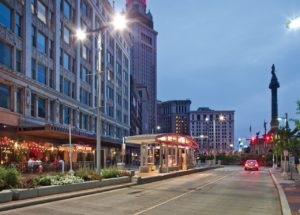Building Healthy Corridors: A New ULI Publication Shows How to Transform Commercial Strips into Vibrant, Healthy, and Appealing Places
WASHINGTON – November 17, 2016 – (RealEstateRama) — The challenging but rewarding process of transforming drab, lifeless, auto-dependent commercial corridors into vibrant, walkable, healthy hubs is explored in Building Healthy Corridors: Transforming Urban and Suburban Arterials into Thriving Places, a new publication from the Urban Land Institute (ULI).

“Across the United States, cities are looking for ways to become livable, sustainable, economically vibrant, and healthy,” said ULI Senior Vice President Rachel MacCleery, who directed the report. “However, nearly every community is challenged by the prevalence of automobile-centric commercial corridors characterized by a wide road with multiple lanes; limited transit service; buildings separated from the street by parking lots; unsightly utility poles and wires; a lack of trees and vegetation; and narrow, poorly-maintained sidewalks. Commercial corridors should be considered assets that can be redeveloped to support civic life, enhance economic development, and serve as neighborhood resources.”
Building Healthy Corridors applies a health-oriented lens to revitalization of urban and suburban arterials—which are often flanked by low-income and disadvantaged neighborhoods—that considers how the corridor contributes to or detracts from the overall health of the surrounding community, including opportunities for physical activity as well as safety, affordable housing, connections to economic opportunity, access to healthy food, environmental sustainability and social cohesion. This holistic focus encompasses all aspects of rejuvenation, including redesigning the arterials to make them safer and better connected to surrounding neighborhoods, as well as retooling land uses along the corridors to better serve the daily needs of community residents. To ensure that corridor improvements benefit all community residents, the report recommends engaging local stakeholders throughout the process; retaining affordable housing to help prevent resident displacement; and developing strategies to promote and retain local businesses.
The report is based on work conducted through ULI’s Healthy Corridors project, which is supported by the Robert Wood Johnson Foundation and the Colorado Health Foundation and administered through ULI’s Building Healthy Places initiative. Through the initiative, ULI is leveraging the power of ULI’s global networks to shape projects and places in ways that improve the health of people and communities. The first phase of the Healthy Corridors project, which started in 2014, involved four demonstration corridors – Federal Boulevard in Denver; Vista Avenue in Boise; Van Nuys Boulevard in Los Angeles; and Charlotte Avenue in Nashville.
ULI worked with its district councils in those cities and the ULI/National League of Cities Rose Center for Public Leadership in Land Use to engage local stakeholders in developing strategies to revive and reinvent the corridors as appealing hubs that add economic and quality-of-life benefits to the surrounding communities. A new $1.5 million grant to ULI from the Robert Wood Johnson Foundation, along with a new $250,000 grant from the Colorado Health Foundation, is helping the Institute expand its work in those cities and spur corridor revitalization in other cities across the U.S.
Based on lessons learned from the project, the report defines a healthy corridor as one with land uses and services that allow residents to more easily make healthy lifestyle choices, and that reflects the culture of the community, promotes social cohesion, facilitates healthy eating and active living, connects to economic and educational opportunities, provides housing and transportation choices, and adapts to the needs of residents. Components that constitute a healthy corridor include:
- Improved access for pedestrians and cyclists, such as walkways and dedicated bike lanes or trails
- Safe, inviting sidewalks and streetscape amenities such as benches, trees and ample lighting
- Vibrant retail and healthy food options
- Mixed-income housing
- Improved parking strategies such as shared parking
- High-quality, safe open space
- Engagement of residents and local business owners
- Accommodations for vulnerable groups including children, the elderly and the disabled
- A distinguishing identity that draws on the culture and/or heritage of the community
- Well-connected, multi-modal street networks
- Efficient, reliable transit services
ULI has a long history of exploring ways to revitalize urban corridors and neighborhoods with a particular emphasis on redeveloping and adapting properties to make them more pedestrian friendly and more appealing as neighborhood gathering places. The Healthy Corridors project is part of the Institute’s ongoing pursuit of design and development practices that are environmentally conscious, economically sound, and which provide community-wide benefits.
“Through corridor revitalization that is focused on health, communities can become more economically vibrant, equitable, sustainable and attractive places,” the report states. “The healthy corridors approach helps all involved in corridor redevelopment and community revitalization – the public sector, private sector, nonprofits, and neighborhood advocacy groups – work together to create a better future.”
About the Urban Land Institute
The Urban Land Institute is a nonprofit education and research institute supported by its members. Its mission is to provide leadership in the responsible use of land and in creating and sustaining thriving communities worldwide. Established in 1936, the institute has nearly 40,000 members worldwide representing all aspects of land use and development disciplines. For more information, please visit uli.org or follow us on Twitter, Facebook, LinkedIn, and Instagram.
contact: Trisha Riggs at 202-624-7086
by Robert Krueger














